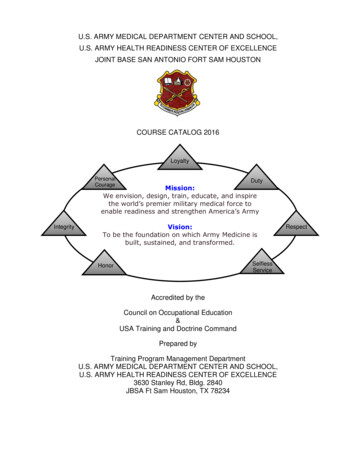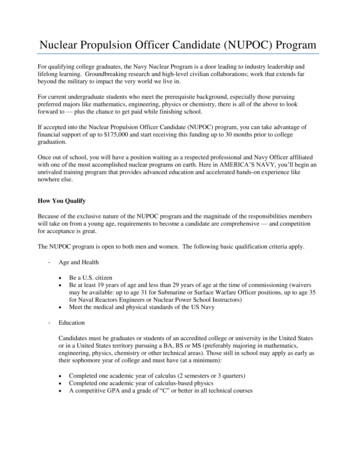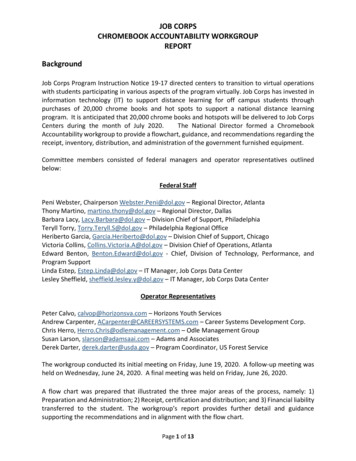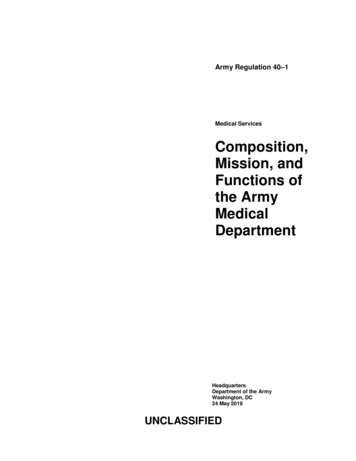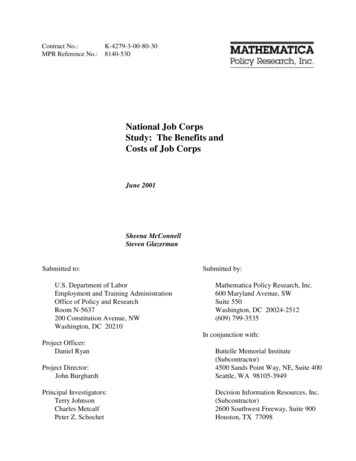
Transcription
Contract No.:MPR Reference No.:K-4279-3-00-80-308140-530National Job CorpsStudy: The Benefits andCosts of Job CorpsJune 2001Sheena McConnellSteven GlazermanSubmitted to:U.S. Department of LaborEmployment and Training AdministrationOffice of Policy and ResearchRoom N-5637200 Constitution Avenue, NWWashington, DC 20210Submitted by:Mathematica Policy Research, Inc.600 Maryland Avenue, SWSuite 550Washington, DC 20024-2512(609) 799-3535In conjunction with:Project Officer:Daniel RyanProject Director:John BurghardtBattelle Memorial Institute(Subcontractor)4500 Sands Point Way, NE, Suite 400Seattle, WA 98105-3949Principal Investigators:Terry JohnsonCharles MetcalfPeter Z. SchochetDecision Information Resources, Inc.(Subcontractor)2600 Southwest Freeway, Suite 900Houston, TX 77098
This report has been produced under Contract Number K-4279-3-00-80-30 with the U.S. Departmentof Labor, Employment and Training Administration. The contents of the report do not necessarilyreflect the views or policies of the Department of Labor, nor does mention of trade names,commercial products, or organizations imply endorsement of these by the U.S. Government.ii
ACKNOWLEDGMENTSWe would like to thank the many people who contributed to this report. We wouldespecially like to thank John Burghardt and Peter Schochet from Mathematica, who wereinvolved in every stage of the benefit-cost analysis and made valuable contributions to the designof the study, the interpretation of the findings, and the content of the report. Walter Corson,Chuck Metcalf, and Craig Thornton of Mathematica and members of the study advisory panelalso made important contributions to the analysis. Walter Corson also provided manysuggestions on an earlier draft of the report.Daniel Ryan, project officer for the study, provided advice and guidance throughout thestudy and useful comments on an earlier draft of the report. We are also grateful to StevenPuterbaugh of the National Office of Job Corps who provided us with data on programexpenditures and patiently answered our many questions about the data. We also thank the staffat Job Corps centers who provided us with data on grants, donations, and volunteers at theircenters. The benefit-cost analysis drew extensively on the impact analysis, and we would like tothank everyone whose efforts made that part of the study successful.We are also indebted to the many people who provided valuable advice on specific technicalissues related to the analysis, including David Card of the University of California, Berkeley,Karen Needels and Chris Ross of Mathematica, and David Weiner of the U.S. CongressionalBudget Office.April Grady, Ruo-Jiao Cao, and Joan James provided expert programming assistance.Walter Brower provided valuable editorial assistance and Felita Buckner did an excellent jobproducing the report.iii
CONTENTSEXECUTIVE SUMMARY. xvI.INTRODUCTION. 1A.OVERVIEW OF JOB CORPS. 21.2.3.4.5.B.OVERVIEW OF THE NATIONAL JOB CORPS STUDY . 71.2.3.C.II.Outreach and Admissions. 3Job Corps Center Services. 3Placement . 5Characteristics of Youths Served by Job Corps . 5Policy Changes Related to Violence and Drugs. 6Research Questions . 7The Impact Analysis. 8Key Findings from the Impact and Process Studies. 14ORGANIZATION OF THE REST OF THE REPORT. 15OVERVIEW OF METHODOLOGY . 17A.BENEFITS AND COSTS INCLUDED IN THE ANALYSIS . 171.2.3.B.DIFFERENT PERSPECTIVES ON BENEFITS AND COSTS. 221.2.C.Three Different Perspectives . 23Transfers. 24APPROACH TO MEASURING BENEFITS AND COSTS. 241.2.3.D.Benefits. 18Costs . 21Unmeasured Benefits and Costs. 22Impact Estimates . 25Converting Impacts into Benefits and Costs with Dollar Values. 26Use of Average Costs . 27EXTRAPOLATING BENEFITS AFTER THE OBSERVATION PERIOD . 27v
CONTENTS (continued)E.COMPARING BENEFITS AND COSTS THAT OCCUR AT DIFFERENTTIMES . 281.2.F.Presenting All Benefits and Costs in Constant Dollars. 28Discounting Future Benefits. 29SENSITIVITY OF THE BENEFIT-COST ESTIMATES. 30III. BENEFITS FROM INCREASED OUTPUT. 33A.INCREASED OUTPUT FROM EMPLOYMENT DURING THEOBSERVATION PERIOD . 341.2.3.B.Approach to Measuring Output. 36Estimates of the Value of Fringe Benefits. 36Estimates of Increased Output During the Observation Period . 41INCREASED OUTPUT AFTER THE OBSERVATION PERIOD. 421.2.3.Time-Pattern of Earnings Impacts During the Observation Period . 43Evidence on the Time-Pattern of Earnings Impacts from Other Studies . 43Approach to Extrapolating the Increased Output . 47C.INCREASED CHILD CARE COSTS . 50D.INCREASED TAXES. 54E.OUTPUT PRODUCED DURING VOCATIONAL TRAINING. 57F.SUMMARY . 60IV. BENEFITS FROM REDUCED USE OF PROGRAMS AND SERVICES OTHERTHAN JOB CORPS . 63A.REDUCED USE OF OTHER EDUCATION AND TRAININGPROGRAMS . 631.2.3.B.Impacts on the Use of Other Education and Training Programs. 64Costs of Attending Other Education and Training Programs. 67Benefits from the Reduced Use of Other Education and TrainingPrograms. 71REDUCED USE OF PUBLIC ASSISTANCE . 72vi
CONTENTS (continued)1.2.3.Impacts on the Use of Public Assistance . 73Costs of Public Assistance . 76Benefits from the Reduced Use of Public Assistance . 77C.REDUCED USE OF SUBSTANCE ABUSE TREATMENT PROGRAMS. 77D.SUMMARY . 78V. BENEFITS FROM REDUCED CRIME . 81A.FRAMEWORK . 821.2.3.4.5.B.REDUCED CJS PROCESSING . 871.2.3.C.Impacts on Arrests. 87CJS Costs per Arrest . 89Benefits from Reduced CJS Processing . 92REDUCED CRIME VICTIMIZATION . 921.2.3.4.D.Two Sources of Benefits . 83Crime Types . 84Timing of Benefits . 84Crime Against Participants. 85Unmeasured Benefits . 86Impacts on Victimizations. 92Costs per Victimization. 94Benefits from Reduced Victimization by Participants . 98Benefits from Reduced Victimization Against Participants . 98SUMMARY . 100VI. PROGRAM COSTS. 105A.APPROACH TO ESTIMATING PROGRAM COSTS. 1061.2.3.4.5.B.Sources of Data . 106Years Included in the Cost Analysis . 107Estimating Costs per Slot-Year, per Participant-Year, and perParticipant. 107Estimating the Costs of Residential and Nonresidential Participants . 109Adjusting for Unusually Low Capacity Utilization . 110REPORTED OPERATING COSTS . 113vii
CONTENTS (continued)C.UNREPORTED OPERATING COSTS. 117D.CAPITAL COSTS. 119E.TRANSFERS: COSTS OFFSET BY BENEFITS TO PARTICIPANTS. 122F.SUMMARY AND SUBGROUP ANALYSIS. 1241.2.Summary . 124Costs by Subgroup . 126VII. SUMMARY OF BENEFITS AND COSTS . 133A.COMPARING OVERALL BENEFITS AND COSTS: IS JOB CORPSCOST-EFFECTIVE?. 1341.2.3.B.SUMMARY OF SENSITIVITY ANALYSES . 1431.2.C.Assumptions Related to Benefits After the Observation Period . 143Other Assumptions . 146ASSESSING CHANGES IN THE BENEFITS AND COSTS OVER TIME . 1471.2.3.D.Benefits and Costs by Perspective . 134Benefits and Costs for Subgroups of Youth. 142Unmeasured Benefits and Costs. 143Differences in the Program and the Context in Which It Operates. 148Comparison of the Study Methods. 149Comparison of the Findings . 151CONCLUDING OBSERVATIONS . 153REFERENCES . 155APPENDIX A: SUPPLEMENTAL TABLESAPPENDIX B: SENSITIVITY ANALYSESAPPENDIX C: DISCOUNTING AND EXTRAPOLATION APPROACHAPPENDIX D: ESTIMATION OF THE COST OF FRINGE BENEFITSAPPENDIX E: LIFETIME CHANGES IN THE RETURNS TO SCHOOLING:EVIDENCE FROM THE NATIONAL LONGITUDINAL SURVEYOF YOUTHviii
CONTENTS (continued)APPENDIX F: ESTIMATION OF THE BENEFITS OF REDUCED CRIMEAPPENDIX G: ESTIMATION OF THE COST DIFFERENCES BETWEENRESIDENTIAL AND NONRESIDENTIAL SLOTSAPPENDIX H: ESTIMATION OF UNREPORTED CENTER OPERATING COSTSAPPENDIX I: BENEFITS AND COSTS FOR SELECTED SUBGROUPSix
TABLESII.1MEASURED BENEFITS AND COSTS OF PARTICIPATING IN JOBCORPS, BY PERSPECTIVE. 19III.1BENEFITS FROM THE INCREASED OUTPUT OF JOB CORPSPARTICIPANTS DURING THE OBSERVATION PERIOD. 35III.2AVAILABILITY OF FRINGE BENEFITS FOR ALL U.S. EMPLOYEESAND RESEARCH SAMPLE MEMBERS . 38III.3ESTIMATES OF THE COST OF FRINGE BENEFITS AS A PERCENTAGEOF EARNINGS FOR ALL SAMPLE MEMBERS WHO WORK. 40III.4IMPACTS ON CHILD CARE COSTS . 51III.5IMPACTS ON TAXES IN THE OBSERVATION PERIOD . 55III.6ESTIMATES OF THE VALUE PRODUCED BY JOB CORPS STUDENTSDURING VST AND WE PROJECTS IN THE COMMUNITY. 59III.7BENEFITS FROM INCREASED OUTPUT. 61IV.1BENEFITS FROM REDUCED ATTENDANCE AT OTHER EDUCATIONOR TRAINING PROGRAMS . 65IV.2IMPACTS ON ATTENDANCE AT OTHER EDUCATION OR TRAININGPROGRAMS, BY YEAR . 67IV.3BENEFITS FROM THE REDUCED USE OF PUBLIC ASSISTANCE . 74IV.4IMPACTS ON THE RECEIPT OF AFDC/TANF, FOOD STAMPS, SSI/SSA,OR GENERAL ASSISTANCE, BY YEAR . 75IV.5BENEFITS FROM A REDUCTION IN THE USE OF SUBSTANCE ABUSETREATMENT PROGRAMS. 78IV.6BENEFITS FROM THE REDUCED USE OF OTHER PROGRAMS ANDSERVICES . 79V.1BENEFITS FROM REDUCED CRIMINAL JUSTICE SYSTEMPROCESSING OF CRIMES COMMITTED BY JOB CORPSPARTICIPANTS. 88V.2COMPONENTS OF THE CJS COST OF MURDER . 91xi
TABLES (continued)V.3BENEFITS FROM REDUCED CRIMINAL VICTIMIZATION IN CRIMESCOMMITTED BY JOB CORPS PARTICIPANTS . 95V.4BENEFITS FROM REDUCED CRIME AGAINST PARTICIPANTS . 99V.5BENEFITS FROM REDUCED CRIMINAL ACTIVITY . 102VI.1AVERAGE REPORTED PROGRAM OPERATING COSTS FORRESEARCH SAMPLE PARTICIPANTS . 114VI.2COSTS NOT REPORTED ON PROGRAM FINANCIAL REPORTS. 118VI.3TRANSFERS PER PARTICIPANT. 124VI.4SUMMARY OF COSTS PER PARTICIPANT . 125VI.5PROGRAM COSTS BY DESIGNATED RESIDENTIAL STATUS ANDCENTER TYPE . 128VI.6REPORTED OPERATING COSTS PER SLOT, BY DESIGNATEDRESIDENTIAL STATUS. 130VII.1BENEFITS AND COSTS OF JOB CORPS, BY PERSPECTIVE. 135VII.2ASSUMPTIONS REQUIRED FOR BENEFITS TO EXCEED COSTS. 145VII.3ASSUMPTIONS THAT HAVE THE LARGEST EFFECTS ON BENEFITSAND COSTS DURING THE OBSERVATION PERIOD. 148VII.4COMPARISON OF FINDINGS FROM 1982 AND CURRENT BENEFITCOST ANALYSES OF JOB CORPS. 152xii
FIGURESIII.1AVERAGE EARNINGS OF PROGRAM AND CONTROL GROUPMEMBERS, BY QUARTER . 44III.2COMPOSITION OF THE IMPACT ON TAXES IN THE FOURTH YEAROF THE OBSERVATION PERIOD . 57IV.1COMPOSITION OF THE BENEFITS FROM THE REDUCED USE OFEDUCATION AND TRAINING PROGRAMS. 72IV.2BENEFITS TO SOCIETY FROM THE REDUCED USE OF OTHERPROGRAMS AND SERVICES, BY TYPE OF PROGRAM OR SERVICE. 80V.ICOMPONENTS OF BENEFITS FROM REDUCED CRIME . 82V.2BENEFITS TO SOCIETY FROM REDUCED CRIME, BY CATEGORYOF CRIME . 101VI.1REPORTED PROGRAM OPERATING COSTS: PY 1991 TO PY 1999. 111VI.2CONSTRUCTION, REHABILITATION, AND ACQUISITIONEXPENDITURES PER SLOT. 120VII.1BENEFITS AND COSTS TO SOCIETY. 136VII.2BENEFITS AND COSTS TO PARTICIPANTS . 140VII.3BENEFITS AND COSTS TO THE REST OF SOCIETY . 141xiii
EXECUTIVE SUMMARYJob Corps plays a central role in federal efforts to provide employment assistance todisadvantaged youths. The program’s goal is to help disadvantaged youths become moreresponsible, employable, and productive citizens by providing intensive and comprehensiveservices, including education, vocational skills training, and counseling. The services are mostlyprovided in a residential setting. Each year, Job Corps serves more than 60,000 new enrollees ata cost of more than 1 billion.The National Job Corps Study, funded by the U.S. Department of Labor, was designed toprovide information about the effectiveness of Job Corps in attaining its goal. The cornerstoneof the National Job Corps Study was the random assignment of all youths found eligible for JobCorps to either a program or a control group. Program group members could enroll in JobCorps. Control group members could not, but they could enroll in all other programs available tothem in their communities.This report presents the findings of a benefit-cost analysis of Job Corps. In a benefit-costanalysis, a dollar value is placed on each program impact. By measuring impacts in dollars, abenefit-cost analysis enables policymakers to compare the diverse benefits of Job Corps with itscosts. It provides a way of assessing the relative size of each impact and the cost-effectivenessof the program as a whole.Our findings suggest that Job Corps is a good investment: the benefits to society exceed thecosts of the program by nearly 17,000 per participant (Table 1). The finding that benefitsexceed costs holds under a wide range of plausible assumptions and for most groups, includingboth residential and nonresidential students. It does, however, depend critically on theassumption that the earnings impacts observed during the study do not decline rapidly asparticipants get older. Observations during the study and evidence from other research suggestthat these impacts will indeed persist without rapid decay.STUDY METHODOLOGYA diverse set of benefits and costs was included in the analysis. The measured benefits andcosts fall into four categories:1.The benefits of increased output resulting from the additional productivity of JobCorps participants2.The benefits from reduced use of other programs and services, including othereducation and training, public assistance, and substance abuse treatment programs3.The benefits from reduced crime committed by participants as well as the benefitsfrom reduced crime committed against participantsxv
TABLE 1BENEFITS AND COSTS OF JOB CORPS, BY PERSPECTIVE(1995 Dollars)PerspectiveParticipantsRest ofSociety 27,531 17,773 9,758-1,883-500-1,883-473090-4-309Years 2 to 4Increased Earnings and Fringe BenefitsIncreased Child Care CostsIncreased Taxes2,558-9602,558-77-8550-19855After the Observation PeriodIncreased Earnings and Fringe BenefitsIncreased Child Care CostsIncreased enefits from Reduced Use of Other Programs and ServicesReduced Use of High SchoolReduced Use of Other Education and Training ProgramsReduced Use of Public Assistance and SubstanceAbuseTreatment Benefits From Reduced CrimeReduced Crime by ParticipantsReduced Crime Against Participants1,2401,240064306435971,240-643Program CostsReported Program Operating Costs (Net of Transfers)Unreported Program Operating Costs (Net of Transfers)Capital CostsStudent Pay, Food, and Clothing 16,489-12,540-551-1,037-2,361Net BenefitsaNet Benefits per Dollar of Program Expendituresb 16,8292.02 19,997- 3,168Benefits or CostsSocietyBenefits from Increased OutputYear 1Increased Earnings and Fringe BenefitsIncreased Child Care CostsIncreased TaxesOutput Produced During Vocational Training in Job CorpsSOURCE:Tables III.7, IV.6, V.5, and VI.4aBecause of rounding, net benefits may not equal the sum of the rows. Similarly, benefits to society may not preciselyequal the sum of the benefits to participants and the benefits to the rest of society.bThe ratio of benefits to costs from each perspective depends partly on arbitrary decisions, such as whether year 1 output issubtracted from benefits or added to costs, and hence it is not easily interpretable. To provide a ratio with a usefulinterpretation, we present the amount society gains from each dollar spent on the program. The ratio’s denominator is theamount spent operating the program ( 16,489). The numerator is the benefit to society ( 27,531 2,186 1,240) plusthe cost of student pay, food, and clothing ( 2,361). The cost of student pay, food, and clothing is included in thenumerator to offset the fact that it is included in the denominator even though it is not a cost to society.xvi
4.Program costs, including reported program costs, costs not reported on Job Corps’financial reports, and the economic costs of the capital—land, buildings, furniture,and equipment—used by Job CorpsBenefits and costs were measured from three perspectives: (1) society, (2) participants, and(3) the rest of society. Society’s perspective is the most relevant for policymakers because itindicates whether the aggregate benefits from the program are greater than the resources used bythe program, abstracting from who enjoys the benefits of the program and who bears its costs.Members of society fall into two groups: participants and everyone else (the rest of society).The participants’ perspective indicates whether participating in Job Corps is a good investmentfor the youths themselves. The rest of society’s perspective indicates the magnitude of theinvestment in Job Corps made by taxpayers and other citizens.Most benefits were estimated by multiplying an estimate of the program’s impact by anestimate of the dollar value of the impact. The impacts were estimated using data from surveysconducted soon after random assignment (when youths were first determined eligible toparticipate in Job Corps), and 12, 30 and 48 months afterwards. Most impacts were convertedinto benefits using market prices.We observed our sample members for about three years after they left Job Corps. However,Job Corps aims to make long-term changes in youths’ lives that can be expected to continue wellbeyond our study. We took a long-term, but cautious, approach to account for future benefits.Only benefits that did not decline during the observation period were assumed to continue afterit. Impacts on crime and use of other services and programs declined during the follow-upperiod; hence, we did not measure the future benefits for these impacts. However, impacts onearnings persisted without decline, so we estimated the benefits from these impacts that willoccur after the observation period.We tested the sensitivity of our estimates to alternative assumptions. The benchmarkestimates presented in Table 1 are based on the best available data and, in our judgment, the mostappropriate assumptions. However, recognizing the uncertainty inherent in these estimates andassumptions, we tested the sensitivity of our estimates to alternative estimates and assumptions.This sensitivity analysis plays a role analogous to the role of standard errors in the estimates ofJob Corps impacts.BENEFITS: INCREASED OUTPUTA major goal of Job Corps is to increase the employment and earnings of the youth it serves.Our study concludes that the program meets this goal.The largest benefit of Job Corps is the value of the additional output that participantsproduce. Job Corps participants produced 27,500 more output per participant than their controlgroup counterparts. This includes increased output produced during employment net of increasedchild care costs and the value of the output produced by participants during vocational training.The increased output produced during employment was measured by the increase in participants’total compensation—that is, earnings and fringe benefits.xvii
Output initially decreased in the first year, but then increased in the remaining threeyears of the observation period. In the first year of the observation period, output produced byJob Corps participants was about 1,700 per participant less than that produced by their controlgroup counterparts, reflecting the participants’ forgone employment opportunities while in JobCorps (Figure 1). However, in the remaining three years of the observation period combined,output was about 2,500 per participant higher than in the absence of Job Corps.Output produced after the observation period was estimated to be 26,800 perparticipant. The dollar value of the annual impact on compensation in the last year of theobservation period ( 1,550) was assumed to persist for the rest of the average participants’working lifetime. The rationale for this assumption was:1.The impacts of Job Corps did not decline during the observation period. We foundthat impacts increased during the third year in the observation period and persistedwithout a decline in the fourth year (approximately the second and third year,respectively, after program participation). Long-term studies of the returns to trainingfind that, if returns decline, the decline occurs within two or three years after a traineeleaves the program.2.Job Corps teaches multiple skills. Participants in Job Corps engage not just invocational training but also in academic education and training in social andworkplace skills. Studies of other programs suggest that the impacts from programsthat teach broader skills are more likely to persist.3.Job Corps improved literacy and numeracy skills. We found Job Corps raised scoreson tests of literacy and numeracy skills used in the workplace. These basic skills areless likely to become obsolete over time than more narrow job-specific training.4.The earnings impacts from participation in Job Corps in the fourth year of theobservation period were similar to the returns to a year of school. On average, thereturn to an additional year of school persists without decline for the rest of aworkers’ lifetime.Our approach assumes that the dollar value of the earnings impact persists over time.Because average earnings increase with workers’ age, our assumption implies a decline in theimpact as a percentage of earnings. If instead of assuming a constant-dollar-earnings impact( 1,550) we assumed a constant-proportionate-earnings impact (12 percent), the estimate of thenet benefits of Job Corps would increase substantially.Job Corps increases child care costs. The additional time Job Corps participants spend intraining and employment means they spend less time caring for children in the home and have agreater need for child care outside the home. The cost of this additional child care to society isabout 600 per participant.xviii
FIGURE 1BENEFITS AND COSTS TO SOCIETY(1995 Dollars per Participant) 26,778Net Benefits 16,829 3,425 2,462- 1,709- 14,128Benefits From Increased OutputaYear 1Years 2 to 4After Year 4OtherBenefitsbProgram CostsaIncludes earnings and fringe benefits minus child care costs. Year 1 also includes outputproduced during vocationa
The National Job Corps Study, funded by the U.S. Department of Labor, was designed to provide information about the effectiveness of Job Corps in attaining its goal. The cornerstone of the National Job Corps Study was the random assignment of all youths found eligible for Job Corps to either a program or a control group.


